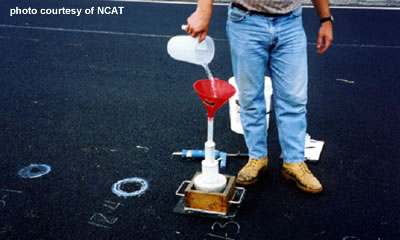It is generally believed that HMA densities between 3 and 8 percent air voids will result in a pavement that would not be susceptible to water damage, oxidation, raveling, and cracking. There is some indication from recent studies that coarse-graded mixes can be excessively permeable to water at in-place air voids less than 8 percent due to their inherently larger void sizes. These larger void sizes increase the chances of their interconnection, which allow easier water entry and infiltration that, in turn, leads to higher permeability. This page summarizes the following report:
- Cooley, L.A.; Prowell, B.D. and Brown, E.R. (2002). Issues Pertaining to the Permeability Characteristics of Coarse-Graded Superpave Mixes. NCAT Report No. 02-06. National Center for Asphalt Technology. Auburn, AL. http://www.eng.auburn.edu/center/ncat/reports/rep02-06.pdf http://www.eng.auburn.edu/center/ncat/reports/rep02-06.pdf
The National Center for Asphalt Technology (NCAT) conducted a study to evaluate the relationship between in-place air voids, lift thickness, and permeability on 23 HMA construction projects. Field permeability tests (see Figure 1) were conducted using a simple device built at NCAT and cores were taken at those same sites to determine density.

Results showed that pavement permeability is affected by (see Figures 2 and 3):
- Density. As density increases, air voids become fewer and smaller and are less likely to be interconnected. Therefore, as density increases permeability decreases.
- Nominal maximum aggregate size (NMAS). Mixes with larger nominal maximum aggregate sizes tend to have larger sized voids, which are more likely to be interconnected. Therefore, at the same air void level, mixes having larger nominal maximum aggregate sizes have more potential for high permeability than mixes of smaller nominal maximum aggregate sizes. Critical density values for different nominal maximum aggregate sizes are:
- 9.5 mm (0.375 inch) NMAS ˜ 7.5 – 8.0 percent air voids (92.0 – 92.5 percent TMD).
- 12.5 mm (0.5 inch) NMAS ˜ 7.5 – 8.0 percent air voids (92.0 – 92.5 percent TMD).
- 19.0 mm (0.75 inch) NMAS ˜ 6.0 – 6.5 percent air voids (93.5 – 94.0 percent TMD).
- 25.0 mm (1 inch) NMAS ˜ 5.5 – 6.0 percent air voids (94.0 – 94.5 percent TMD).
- Lift thickness. As lift thickness increases, it becomes less likely that a series of interconnected voids can span the entire lift depth. Therefore, as lift thickness increases, permeability decreases.
Therefore, lifts with higher density, thicker lifts, and mixes with smaller nominal maximum aggregate sizes are less likely to be permeable.
The study also investigated several ways of measuring field permeability and predicting field permeability through laboratory experiments. They found:
- At permeability values within the typically specified region for a pavement, field and lab permeability test methods provide approximately similar results.
- There is a reasonable relationship between water absorption during bulk specific gravity measurement using the water displacement method and water permeable voids from Corelok testing and permeability results (both field and lab). This may be used as a quick screening test to identify pavements that may be permeable.
- There are some reasonable relationships between the permeability of lab compacted samples and laboratory permeability. These relationships suggest that a mix designer may be able to evaluate the permeability potential of a mix during mix design. Also, a mix designer may be able to compare the permeability potential of different mix designs for a given project.
